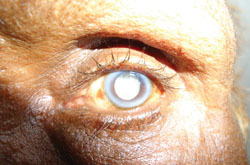5.2.1 Recognition of cataracts
You should suspect cataracts are the problem when a person comes to you with complaints of visual changes, such as blurred vision, difficulty in seeing in bright light, inability to see distant objects or scenes, poor colour vision, and difficulty in reading. As cataracts continue to progress and the lens become more opaque, the person will say they feel like they are looking through cloudy glass. The area of the pupil appears white or cloudy when the cataract is found at a late stage.
Cataracts are usually progressive and painless, and not associated with any redness of the eye. When you look at a person with advanced cataract you can see the clouding or milky appearance of the lens, which is particularly obvious if you shine a light into the eye (Figure 5.5).

Cataracts can sometimes develop in children, but usually the person is above the age of 40 years. If someone complains of these problems, you should suspect cataract and refer this person to the nearest hospital or health centre. The diagnosis that cataract is the cause of the visual problems will be confirmed by examination with a special instrument called a slit-lamp microscope (or simply ‘eye microscope’) to look into the eye.
You should tell the person with suspected cataracts that after the examination at the hospital or health centre, the doctor will discuss if a solution is possible for their sight problems. A simple surgical treatment could transform their vision from not seeing well to being able to see much better again. We will tell you about treatments for cataract later in this study session.
5.2 Cataracts
